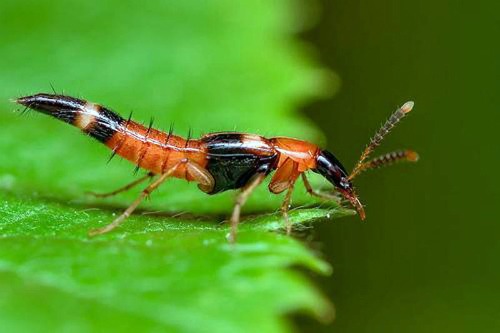According to medical experts, pederin in the secretions of the ant is a type of acid that is 10-15 times more toxic than cobra venom.
Every day, the Dermatology - Skin Aesthetics department of a hospital in Ho Chi Minh City receives 10-15 cases of blistering and skin infections caused by ants during the season.
 |
| Illustration photo. |
The rainy season is the time when the epidemic of three-compartment ants in the South is strong, while in the dry months, this disease is rarely seen. Three-compartment ants are also known as needle ants, sedge ants, locked ants, curved ants, etc., belonging to the genus Paederus, family Staphilinidae, order Coleoptera. Three-compartment ants are characterized by an abdomen divided into three alternating orange-brown and black segments, and a pointed tail.
This type of insect lives mainly in humid places in fields and gardens, often appearing in large numbers during the rainy season when the weather is humid, favorable for them to reproduce and develop. At night, the ants are attracted by white light, so they often fly into the house following the light, landing on clothes, beds, blankets, objects, etc.
Ms. TVHT (32 years old, Ho Chi Minh City) came to the hospital with many clusters of white and yellow pustules on her face, neck, and ears, lasting like scratches. Two days ago, while staying at home on the 27th floor of an apartment building, she saw a small animal the size of a toothpick crawling on the table, so she used her hands to catch and kill it.
The next day, she felt blisters and some pain on her neck. Thinking she had been bitten by an insect, she applied essential oil. The lesions spread more and more, and the itching and burning became more intense. After the doctor showed her a picture of a three-cavity ant, Ms. T. realized that she had come into contact with a type of ant that secretes 10 times more venom than a cobra snake, and that her habit of touching the red and oozing skin was the reason the toxin spread.
Mr. VKL (26 years old, Ho Chi Minh City) was accidentally diagnosed with dermatitis caused by the three-cavity ant when he went to Tam Anh General Hospital in Ho Chi Minh City for an examination due to an allergic reaction, hives, and recurring. Mr. L. said that while sitting in the car on the way to the hospital, he crushed an insect that landed on his face.
About an hour later, his face had itchy, red spots. Doctors diagnosed Mr. L. with hives and contact dermatitis caused by the three-cavity ant.
The two patients were prescribed anti-allergy and anti-inflammatory topical medications. Mr. L.'s condition was more complicated, so he needed tests to check the cause of the hives, oral medications, topical anti-allergy medications containing corticosteroids, and adjustments to the skincare products and functional foods he was using at home.
Usually, the symptoms of dermatitis caused by the poison of the ant are not too severe, can be cured within a week and leave little scarring, mainly dark spots. Dark spots caused by post-inflammatory hyperpigmentation will fade after 2-3 months if the patient protects themselves from the sun carefully.
According to Dr. Nguyen Thi Kim Dung, a specialist in Dermatology - Skin Aesthetics, Tam Anh General Hospital, Ho Chi Minh City, pederin in the secretions of the three-compartment ant is a type of acid that is 10-15 times more toxic than cobra venom, but the amount of this poison in the body of the three-compartment ant is very small, only in contact with the skin, not enough to endanger life.
Pederin is very toxic, just a small amount on the skin will trigger a local inflammatory reaction, causing skin burns, itching, burning, redness due to vasodilation, blistering, vesicles, pustules...
If this poison gets into sensitive areas such as the eyes, it can cause conjunctivitis, corneal damage, and worse, loss of vision, and cause systemic allergies in people with sensitive skin. If the pustules burst and the secretions spread to surrounding areas, similar lesions may appear. Improper care and treatment can easily lead to infection and increase the risk of leaving ugly scars.
Treatment of dermatitis caused by ants is not too difficult, however, the symptoms of ants poisoning and shingles when they first appear are quite similar, such as blisters, pustules on red skin, burning pain and itching.
Many patients mistakenly self-treat by applying leaves, using traditional medicine, folk remedies or going to the pharmacy to buy antiviral drugs, green medicine to treat shingles. Meanwhile, the three-cavity ant must be treated in the direction of contact dermatitis. Using the wrong medicine causes the skin condition to improve slowly or get worse, the skin has many red rashes, clusters of pustules and is very painful.
Doctor Dung pointed out the key difference between these two diseases is that shingles lesions usually only appear on one half of the body, along the nerve distribution, in the form of vesicles or mid-concave bullae, usually clear, sometimes with bleeding.
Lesions caused by the three-compartment ant are often pustules and can be located anywhere the ant's secretions come into contact with. The pain caused by the three-compartment ant's venom is less severe than shingles, with the main sensation being heat or mild itching.
Therefore, patients should not use their bare hands to catch or kill the ants. If there is contact with a risk factor, it is necessary to wash hands or the area in contact with the ants with soap, limit touching and scratching the skin. It is best to go to a medical facility when clusters of pustules appear on the skin for appropriate diagnosis and treatment, especially the elderly, children, and pregnant women.
To prevent the three-cavity ant, Dr. Dung recommends that people install insect screens on doors; keep the house clean and airy, spray insecticide, close doors at night and limit white light from fluorescent lamps to reduce insect attraction. Always shake clothes, towels, and blankets before use to avoid three-cavity ant hiding inside.
Source: https://baodautu.vn/nhung-sai-lam-can-tranh-khi-bi-nhiem-doc-kien-ba-khoang-d221593.html




















































![[Maritime News] More than 80% of global container shipping capacity is in the hands of MSC and major shipping alliances](https://vphoto.vietnam.vn/thumb/402x226/vietnam/resource/IMAGE/2025/7/16/6b4d586c984b4cbf8c5680352b9eaeb0)













































Comment (0)